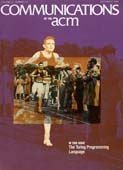December 1988 - Vol. 31 No. 12

Features
The Turing programming language
Turing, a new general purpose programming language, is designed to have Basic's clean interactive syntax, Pascal's elegance, and C's flexibility.
A functional approach to integrating database and expert systems
A new system architecture shares certain characteristics with database systems, expert systems, functional programming languages, and spreadsheet systems, but is very different from any of these.
Productivity enhancement from computer-mediated communication: a systems contingency approach
A systems contingency approach to social impacts of computing predicts that productivity enhancement will be a function of a complex interaction of social and technical systems.
User interface design from a real time perspective
Using a data flow diagram (DFD) to represent the functional requirements of a system to be developed, an analysis of a real-time perspective is augmented to generate user interface specifications. By applying a set of heuristics, these specifications facilitate the design of three user interface styles: question/answer, menu/form, and command language.
A model for predicting and evaluating computer resource consumption
Evaluation and prediction of computer resource consumption can aid in the determination of computer selection and configuration planning as well as in the usefulness and maintenance of existing systems. The model presented can be used in a "What If" mode to make these determinations.
Experimental investigation of an interior search method within a simplex framework
A feasible direction method for solving Linear Programming (LP) problems, followed by a procedure for purifying a non-basic solution to an improved extreme point solution have been embedded within an otherwise simplex based optimizer. The algorithm is designed to be hybrid in nature and exploits many aspects of sparse matrix and revised simplex technology. The interior search step terminates at a boundary point which is usually non-basic. This is followed by a series of minor pivotal steps which lead to a basic feasible solution with a superior objective function value. It is concluded that the procedures discussed in this article are likely to have three possible applications, which are
(i) improving a non-basic feasible solution to a superior extreme point solution,
(ii) an improved starting point for the revised simplex method, and
(iii) an efficient implementation of the multiple price strategy of the revised simplex method.
The use of memory in text processing
The performance of a natural language processing system should improve as it reads more and more texts. This is true both for systems intended as cognitive models and for practical text processing systems. Permanent long-term memory should be useful during all stages of text understanding. For example, if, while reading a patent abstract about a new disk drive, a system can retrieve information about similar objects from memory, processing should be simplified. However, most natural language programs do not exhibit such learning behavior. We describe in this article how RESEARCHER, a program that reads, remembers and generalizes from patent abstracts, makes use of its automatically generated memory to assist in low-level text processing, primarily involving disambiguation that could be accomplished no other way. We describe both RESEARCHER's basic understanding methods and the integration of memory access. Included is an extended example of RESEARCHER processing a patent abstract by using information about several other abstracts already in memory.



